Another Adventure to the Dark Side
A REVIEW OF THE LINE6 POD HD500X
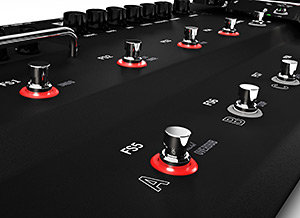
HOW WE GOT HERE
Modeling isn't new in the studio. In fact, my own rather belated review of the POD 2.0 showed up on this site way back in 2006, HERE, if you are interested. Since then I've had the opportunity to compare tube amps and modelers in the studio. I love my tube amps, but many of my sessions lately haven't demanded that I lug out the amps because a modeler can often create a comparable product, and can do so with less muss, fuss, and racket. I know, I know: Traitor. "It's not real," etc. But the studio is ultimately a place of pragmatism and in the studio, modelers work, darn it. For that matter, at 6:30am when I'm loading out, I do congratulate myself on not having to tote out multiple guitars, amps and effects. And it's not as if I'm going to ditch my tube amps, for heaven's sake. Instead I'm developing, shall we say, parallel signal chains.
Lately, even though I've developed some really great tweaked presets, my modeler has been seeming a bit, um, long in tooth. So for a while I've been eyeing a move into "the present." I starting by doing my homework: It seems that the Axe-FX is the boutique favorite. As if to witness, one of my favorite classic progressive guitar bands, Wishbone Ash, just recorded their latest dual-guitar album, Blue Horizon, entirely with the Axe-FX and it sounds fantastic! But that system costs over two grand and to many its quality is not "in scale" for its cost, which is four times the cost of the nearest competition. Next, Avid Eleven Rack is quite good, but many are already considering it dated. It is also designed to mate exclusively with a single DAW platform, Avid's Pro Tools, and I work sessions with other platforms. With those considerations, the next thought goes to Line6 and their newish (July 2013) POD HD500X, a development of the existing HD500, the working man's modeling machine. In keeping with my policy of staying behind the "bleeding edge" and its software teething issues and cost I hadn't been in a rush to shell out without allowing the bugs to shake out. I've also wanted a chance to put the new Pod through its paces in depth but none of the local places has a quiet room to test it. So, at its price point I've been reticent to just throw down for it lest I end up with a pig in a pedal.
But recently when I was in Guitar Center using my "Free Strings of the Month" card, 'lo and behold, I spied an unboxed HD500X sitting in the display case. It was used but in absolutely mint condition with all cables and manuals. It even had the little protective plastic sheet from the factory still over the display screen. A fellow had just brought it in that morning and the store had just listed it in their used gear database. I was able to get my hands on it and "grok" it. Very important. They were asking $150 less than the new price and I had a ten-dollar GC e-gift certificate burning a hole in my iPhone as well. At that price and in that condition I knew it was "you snooze, you loose." More importantly, my wife pushed me to grab it. Holy garbonzoly, Batman! I snapped it up, and just in time, too, because a guy from California was on the phone and ready to buy it.
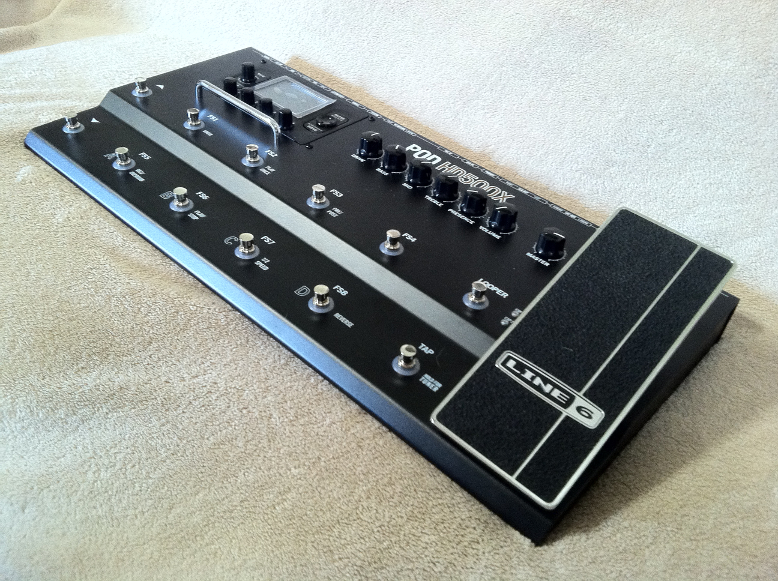
LEARNING CURVE
So for a few weeks I've been pouring over the the Quick Start Pilot's Guide, the Advanced Guide, the Computer Editor Pilot's Guide, and the "Model Gallery." Four reference books. Yeah, I read all that stuff. How else can I give you a decent review? I've downloaded and installed the computer editing software, studied the interface, and strapped in for the ride. With the rig connected to play through my studio monitors I've spent hours learning, listening, and tweaking. It is easiest to download the user guides onto an iPad and sit with the pedal in front of you, the software on the laptop beside it, and the manual on the iPad next to you. Surrounded by technology. It's a brave new world but a good one. Because the first tendency is to try EVERYTHING and end up with nothing useable, I initially restricted myself to working within one amp model in order to learn the deep amp editing capabilities, the hardware, the software, and the processing available. I've been immediately struck by the sheer amount of control offered to those who know what they are doing. For instance, mic and cabinet choices are crucial. The Deluxe Reverb model features the matching Deluxe Reverb 1x12 cab and is mic'd with the Shure SM57 (on-axis). But to my ears, the on-axis SM-57 mic emphasizes the idiosyncratic brattiness of the cranked Deluxe amp. As a person who likes smooth sounds I found the Neumann U67 condenser (smooth), the Royer 121 ribbon (round), or the Sennheiser MD409 or MD421 (neutral), much more pleasing on this amp and cab. No surprises there, I suppose. In real life those mics behave very much as they do in these models. I also found that the HiWatt 4x12 cab makes the amp sound more "spacious." It took me a week but I was able to progress through the typical "real stages of modeling." That sounds strangely and disquietingly psychological and possibly pathological, but those stages really exist: You go from from "raw" to "over-tweaked" with little middle ground and then reel yourself back in to "well-tweaked." It's always good to graduate from that middle, over-cooked stage. I reproduced my previous presets pretty quickly and the new versions sound better, feel better, and offer me more options than their predecessors. If you understand tube amps you'll understand the many deep control parameters and how to make the thing sing for you. But you are probably also a tone crazy obsessive like me already. But here's the deal: You don't have to dig in deep to enjoy the POD. There is a balance: Unless you are a tone crazy you may not understand or care about all that poop anyway.

INS AND OUTS
The input/output and programming possibilities are extremely impressive here as well. Not only does the unit have balanced and unbalanced outputs but it has a second analog guitar input and a mic input that can be independently routed to models and presets. There are also a Line6 Variax input, a 1/8" aux input for an iPod or such, a loop, and S/PDIF and USB digital outputs with variable parameters. There is provision for the unit to control Line6 amps and send or receive MIDI commands as well. The unit's wall-wart power supply is designed to take only a single space on a power strip and a cleat is provided on the back of the Pod to anchor the power cable so it doesn't pull out. Within the unit you can run through effects, amps, cabs, mics, and a near-reflection simulator to add some room sound, or you can pull these steps out as needed. For instance, in the studio I can use the whole shebang and plug directly into the console via the digital or balanced XLR connectors. To play through a guitar amp I can drop the room reflections and/or mic and/or cab and/or power amp section. That means I can back up right to the effects and preamp and use my own physical amp for drive. There are, in fact, preamp-only models for this exact purpose. Then, to rehearse in a small space at low volume and still get the effect of the power amp I can leave the model's amp in and just play through the physical amp clean. There's lots of flexibility. And speaking of the power amp, I have the choice of running the simulated amp at various levels to enjoy the artifacts introduced by a tube amp at various levels. I can change the power amp bias. I can adjust the amount of rectifier sag to essentially go from in your face solid state to a weak tube with lots of compression. I can adjust AC noise and its interaction with the signal.
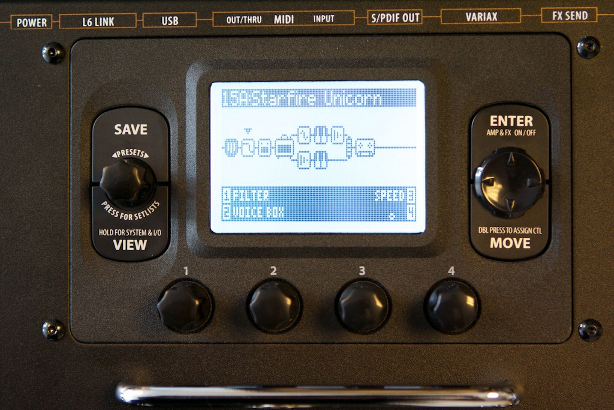
FOR THE HANDS
Your modeled amp's basic front panel controls are available through six large, solid encoders in the upper center section of the front panel. When they are moved, the screen temporarily shifts to a representation of their current location with marks to show you the stored values as well. The screen follows your knob action smoothly. Deeper editing is accomplished through the graphic signal flow screen coupled with five rotary encoders, a round four-way navigation rocker, and a pair of multi-function switches, that operate a deep editing interface shared by the signal flow chart, the amps, and effects. On the chart, the signal flow goes from the input on the left to output on the right and effects can be positioned before or after the amp blocks. There is provision for a stereo or two-channel portion with a mixer. A separate amp and processing can live in each of the two channel legs to give you a more complex and wider stereo stage. You can literally grab a module and drag it around virtually at will. Once you learn to navigate you are free to plumb the depths of the controls behind each of the amps, cabs, and effects via pages of parameters. There are a few controls that seem a tad arcane and hidden from view, but by and large, things make sense after a short familiarization.
FOR THE FEET
Foot control options are also extremely flexible: There are two rows of footswitches with bright LED surrounds. You have the option to assign one footswitch bank to select presets and the other to switch effects on and off or you may task them both to one duty. There is an onboard expression pedal (with a toe switch) that can be assigned to any parameter of any effect or to multiple ones simultaneously. Range of motion limits can be set for each unit controlled. There is also provision to add a second expression pedal as needed and assign other effect controls to it, so for instance you could have volume and wah pedals. It doesn't end there, though: you can assign a pedal to control the delay length of a delay or sweep rate of a modulation effect. You are really only limited by your own imagination and/or needs. As per the previous POD versions, the Tap Tempo and Tuner options share a switch: tap to set tempos and hold to tune. Then there's the looper which uses the banks of footswitches when it is engaged. It allows up to 48 seconds of record time and can be manipulated to record, play, play once, stop, undo, reverse, pre/post (determines whether amp sounds will be added during recording or in playback), and speed change. It is possible to jump between sound presets as you add layers to the loop in order to add interest to the mélange.
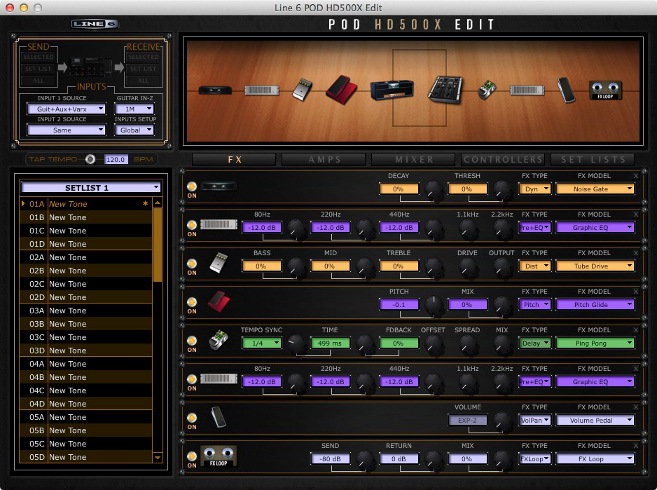
FOR THE MOUSE
Available for both Mac and PC, the computer editing software improves the human interface considerably. With it you can easily edit and store presets, set lists, and "clusters" of the entire memory of the unit onto your computer's drive and also import presets as well, allowing you to share them over the Internet with other users. The basic interface is split between a graphic representation of the signal chain of the current sound, a list showing the current preset's location, and a large field divided between a line of tabs at the top to switch the display area below to display FX, amps, cabs, etc, via horizontal "panels" representing the items contained within the tabs. Virtually every item on the screen can be clicked and edited. There are both knobs and value boxes for most parameters. Knobs can be twirled via mouse, mouse wheel, or keyboard arrows and/or numerical values can be entered via keyboard. In the graphical display and preset lists, items can be dragged about willy-nilly to suit your goals. It's all rather intuitive. There doesn't appear to be iOS-type software or an interface on the horizon because Line6 has developed a simplified line, Amplifi, to work with iOS.
FOR THE STOMPBOX-ADDICTED
On the processing front you have a wide palette of stomp box and studio processing models from both tube and solid-state Echoplexes to several types of stereo digital delays. Interestingly, the Echoplex models which were known to color both clean and effects signals are modeled in two forms: one form models the processor's effect on both signals the other models the unit's effect on the effects side only. For high-gain sounds there is a noise gate. I can report that it does a magnificent job of cleaning up even the hash from P-90 pickups. The effects are rather well-rendered and offer plenty enough flexibility to keep you fiddling for months. I was heartened to see and hear a Mutron Biphase dual phase shifter model. The BiPhase was a short-lived but extremely unique deluxe phase shifter that had two phase shifters built into one box. One rather unique effect available only with the BiPhase was a stereo synched effect where one side was sweeping upwards while the other, in sync, was sweeping downwards. Ever since Mike Rutherford of Genesis used it on "Follow You, Follow Me" from the '78 Genesis album, And Then There Were Three..., and a studio I worked at bought one, I'd wanted a Biphase. They were discontinued in the '80s and many of the extant units began breaking down so the used prices shot through the roof. I can happily tell you that one of the first presets I built on the HD500x was a recreation of Mike's sound so that I could play "Follow You, Follow Me," which is "our song," for my wife for the first time. Just add a palm-muted guitar on the neck pickup!
FOR THE EARS
But the sounds. What about the silly sounds? I've got to say that the fleet of sounds offered by the "HD" generation of the POD is a great move forward. The clarity of the sounds has greatly improved over the earlier models. There are twenty amp models available along with matching preamp-only models and 112 effects models, representing both guitar stompboxes and studio effects. Are they exact reproductions? Hmmm... I've always chased a sound that lives inside my head, so to me, the actual physical gear has mostly been a means to an end. This modeler provides a great tool for that quest, and that's the whole point for me. Meanwhile over the years, the palette of actual amps and effects I have access to has grown so I can compare several of these. I can say that the flavor of these amps and processors has been very nicely captured. I can also say that the sounds are quite musical and useful in a combo setting. That criterion is VERY IMPORTANT.
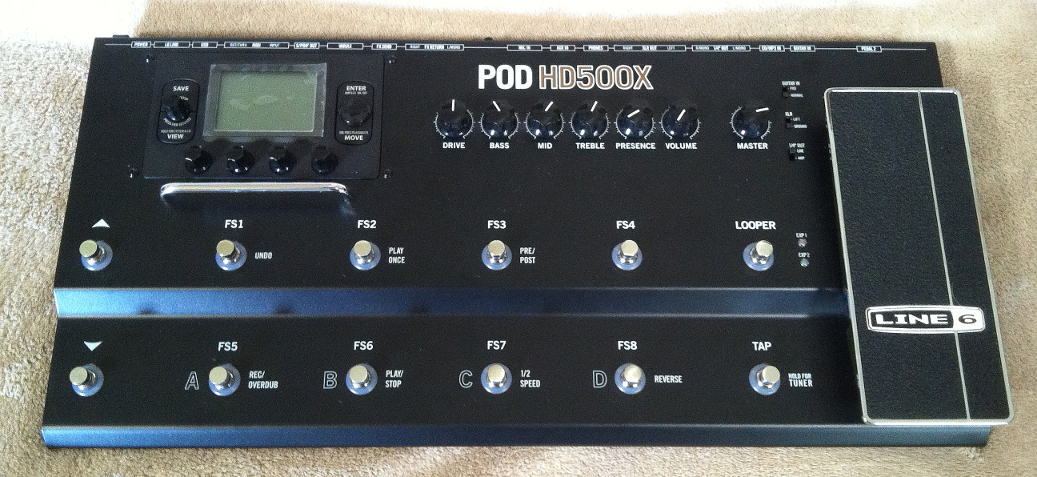
PRACTICAL APPLICATION
Early on I was challenged to reproduce the sound of the Tweed Fender 5E3 Deluxe from the late fifties. The POD offers the 5F6-A Tweed Bassman but it is a different beastie. While the 5E3 is cathode-biased, the Bassman is fixed-bias, so there will be one factor (bias change with envelope) that will be hard to model on a fixed-bias model. However, I successfully chased a particular 5E3 clean tone, the clean solo tone from the Eagles song, "I Can't Tell You Why." I started with the same guitar as the original, a Gibson ES-335. Then, working by ear, I monkeyed with the "sag" on the fixed-bias Bassman, setting it up high to increase the sustain and touch sensitivity. I put it through the 1x12 Blackface Deluxe Reverb cab (yes, a ceramic magnet speaker, I know), and changed to a Neumann U-67 mic. After auditioning several, I added a pinch of Vetta Compressor and was able to reproduce the clean sound on that recording really, really well. That preset is saved! Perhaps a touch of a very light envelope follower placed post-amp can mimic the interesting frequency sweep of the cathode bias.
This gives you an idea of the tools you have at your disposal to develop your sounds.
CONCLUSIONS
All and all, this is a great step forward and an excellent tool for the studio and stage. There are improvements in all areas that make using the tool handier and make the unit more flexible. The sounds are a vast improvement and the amount of control available for tweak heads is outstanding. The sheer amount of storage and the set listing capabilites add a lot of live functionality. Of course, there are trade offs: I miss having the two built-in expression pedals from floorboard days because I have some stock stuff I does that utilizes two. I'll have to throw down on a second pedal now. The Moog pedal, for instance, is inexpensive and well-rated. The interface is more complex so those who struggled with the earlier models will find it more challenging. That, however, is a fact of the universe - more flexibility breeds more complexity. And let's be honest, as a rotary speaker connoisseur, I can say that the onboard rotary sound isn't quite all that. Not surprising - that sound is extremely complex and hard to model. I'll be keeping my H&K Rotosphere and Motion Sound Rotary speaker amp.
So, what is missing? The color. That red color. Vintage POD beans were painted in metallic red, and as everyone knows, red is always better. I miss that, and the lovely, witty, glossy, red, bound POD Pilot's Handbook included in the POD 2.0 package. A .PDF just isn't the same, and the PODHD500X manual is dry prose rather than the witty style that made the old one so endearing. But barring those little niggles, the POD HD500X is a great modeler and one I will be happily integrating it into my studio and live work.
So... How about an audio example or three?
FENDER DELUXE MODEL WITH TELE ON OUTRO SOLO
FENDER DELUXE MODEL WITH ES-335
FENDER DELUXE MODEL WITH TELE RHYTHM AND GRETSCH LAP STEEL LEAD
All Examples recorded directly into mixing console.

LINE6 POD HD500X WEBSITE
DEVICES MODELED
AMP MODELS
Bogner® Uberschall Divided by 13 JRT 9/15
Dr. Z® Route 66
ENGL® Fireball 100
Fender® Tweed Bassman® ("Normal" channel)
Fender® Tweed Bassman® ("Bright" channel)
Fender® Blackface Deluxe Reverb® ("Normal" channel)
Fender® Blackface Deluxe Reverb® ("Vibrato" channel)
Fender® Blackface Twin Reverb® (“Normal” channel with “Bright” switch off)
Fender® Blackface Twin Reverb® ("Vibrato" channel with “Bright” switch on)
Gibson® EH-185
Hiwatt® Custom 100 (DR103)
Line 6 Doom
Line 6 Epic
Line 6 Elektrik
Marshall® JCM-800 (2204)
Marshall® JTM-45 MkII ("Bright" channel)
Marshall® JTM-45 MkII ("Normal" channel)
Marshall® “Plexi” 1959 Super Lead ("Normal" channel)
Marshall® “Plexi” 1959 Super Lead ("Bright" channel) Mesa/Boogie® Dual Rectifier®
Park 75 ("Bright" channel)
Park 75 ("Normal" channel)
Soldano® SLO100(“Clean”)
Soldano® SLO100 (“Crunch”)
Soldano® SLO100 (“Overdrive”)
Supro® S6616
Vox® AC-15
Vox® AC-30 (Top Boost)
Ampeg® B-15NF Portaflex®
DYNAMICS
Noise Gate
Hard Gate
Tube Comp (Teletronix LA-2A)
Red Comp (MXR DynaComp)
Blue Comp (Boss S-1)
Vetta Comp
Boost Comp (MXR MicroAmp)
DISTORTION
Tube Drive (Chandler Tube Driver)
Screamer (Ibanez Tube Screamer)
Overdrive (DOD 250 Overdrive/preamp)
Classic Dist (ProCo Rat)
Heavy Dist (Boss Metal Zone)
Color Drive (Colorsound Overdrive)
Buzz Saw (Maestro Fuzztone)
Facial Fuzz (Arbiter Fuzz Face)
Jumbo Fuzz (Vox Tone Bender)
Fuzz Pi (Electro Harmonix Big Muff Pi)
Jet Fuzz (Roland Jet Phaser)
Line 6 Drive (Colorsound Tone Bender)
Line 6 Distortion
Sub Octave Fuzz (PAiA Roctave Divider)
Octave Fuzz (Tycobrahe Octavia)
PITCH/MOD
Bass Octaver (EBS OctaBass)
Pitch Glide (Digitec Whammy)
Smart Harmony (Eventide H3000)
Pattern Tremolo (Lightfoot Labs Goatkeeper)
Panner
Bias Tremolo (1960 Vox AC-15 Trem)
Opto Tremolo (Blackface Fender Amp Trem)
Script Phase (MXR Phase 90)
Panned Phaser (Ibanez Flying Pan))
Barberpole Phaser
Dual Phaser (Mutron Biphase)
U-Vibe (Uni-Vibe)
Phaser (MXR Phase 90)
Pitch Vibrato (Bos VB-2)
Dimension (Roland Dimension D)
Analog Chorus (Boss CE-1 Chorus)
Tri Chorus (Song Bird/DyTronics Tri-Stereo Chorus)
Analog Flanger (MXR Flanger)
Jet Flanger (A/DA Flanger)
AC Flanger (MXR Flanger)
80A Flanger (A/DA Flanger)
Frequency Shifter
Ring Modulator
Rotary Drum (Fender Vibratone)
Rotary Drum+Horn (Leslie 145)
FILTER
Voice Box (Speaker Driver with Rubber Hose)
V-Tron (Voice Box meets Mutron III)
Q Filter (Parked Wah)
Vocoder
Seeker (Zvex Seek Wah)
Obi Wah (Oberheim Sample/Hold)
Tron Up/Down (Mutron III)
Throbber (Electrix Filter Factory)
Slow Filter
Spin Cycle (Anderton Stereo Wah/Anti-Wah)
Comet Trails
Octisynth
Synth O Matic
Attack Synth (Korg X911)
Synth String (Roland GR700)
Growler (R700 meets Mutron III)
EQ
Graphic EQ
Parametric EQ
Studio EQ (API 550B)
4 Band Shift EQ
Mid Focus EQ
Vintage Pre (Requisite Y7)
DELAY
Ping Pong
Dynamic Delay (TC Electronic 2290)
Stereo Delay
Digital Delay
Dig Delay w/ Mod Reverse
Lo Res Delay
Tube Echo (Echoplex Ep-1)
Tape Echo (Echoplex Ep-3)
Sweep Echo
Echo Platter (Binson Echorec)
Analog W/Mod *Electro Harmonix Deluxe Memory Man)
Analog Echo (Boss DM2)
Auto-Volume Echo
Multi-Head (Roland RE-101)
WAH/VOL
Fassel (Cry Baby Super)
Weeper (Arbiter Cry Baby)
Custom Chrome (Vox V847)
Vetta Wah
Throaty (RMC Real McCoy)
Conductor (Maestro Boomerang)
Colorful (Colorsound Wah-Fuzz)
Volume
Pan
REVERB
Reverb
Plate
Room
Chamber
Hall
Echo
Tile Cave
Ducking
Octo
Spring
‘63 Spring ('63 Fender Brown Sping Head)
Particle Verb
MIC MODELS FOR GUITAR CABS
Shure® SM57 Dynamic, On Axis
Shure® SM57 Dynamic, Off Axis
Sennheiser® MD 409 Dynamic
Sennheiser® MD 421 Dynamic
Coles 4038 Ribbon
Royer® 121 Ribbon
Neumann® U67 Condenser
Neumann® U87 Condenser
MIC MODELS FOR BASS CABS
Shure® SM57 Dynamic, On Axis
Sennheiser® MD 421 Dynamic
AKG® D12
AKG® D112
EV® RE20
Shure® SM7B
Heil® PR40
Neumann® U47
= =
=







